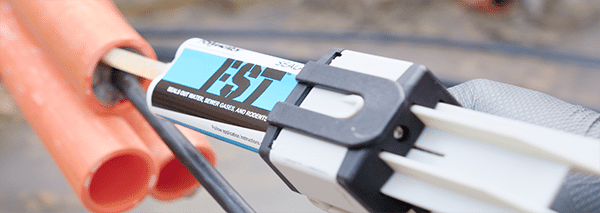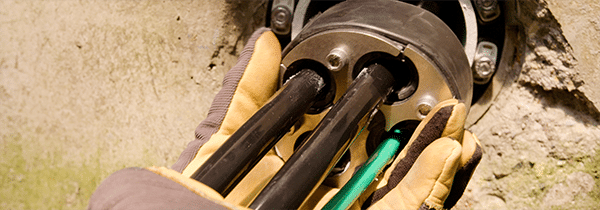How Do You Seal Electrical or Telecommunications Conduits?
Discover 4 ways to seal a conduit carrying wire or cable from the passage of gases, vapors and liquids. Effectively seal conduits with sealant solutions from Polywater®.
Sealing conduit entrances isn’t just a good idea to protect wires and critical equipment from water, gases, fire ants, rodents, snakes, and other pests. In many cases it’s required by safety regulations such as the NESC (National Electrical Safety Code) and NEC (National Electrical Code) (sealing code infographic). Failing to seal conduits with a high-quality product can result in catastrophic equipment failure — so it’s crucial to thoughtfully select a product that not only protects equipment from the elements, but also protects your business’s bottom line.
| Related Content: Is Meeting a Standard Enough?—An Examination of Duct Sealing Code Compliance. |
What is a “Wire Conduit?”
Electrical or telecommunications conduits are tubes or raceways that house and protect electrical wires or communications cables. They are typically rigid in structure and offer rugged protection in extreme environments such as underground or underwater.
From skyscrapers to underground subway systems, “wire conduits” are instrumental for their protection against water, air, pest, and gas intrusion that could damage critical infrastructure.

What Do You Seal Electrical Conduits With?
There are a few different materials and methods, some effective and some not, that are commonly used to seal “wire conduits.” What you choose depends on how accessible you need cables to be, and how durable you need the seal to be.
| Related Content: Duct Seals Prevent Ruinous Water Damage. |
You won’t be surprised to find that the cheapest materials simply don’t hold up over time and that it’s worth investing in a product that’s going to help you do the job quickly and effectively. With that in mind, consider the following ways you can seal electrical conduits:
Expanding 2-Part, Closed-Cell Foam
Engineered foams are formulated specifically for sealing conduits. The two parts mix when dispensed. The foam bubbles (cells) dry and remain intact (closed), creating robust watertight and airtight seals. We highly recommend foams as code-compliant, easy-to-apply, versatile, durable, and re-enterable solutions.
Pros: Easy application. Simply use a caulk gun to inject foam material that evenly distributes inside the conduit.
Cons: Higher up-front cost when compared to open-cell foam formulas. It is also more difficult to access cables when compared to a mechanical seal.

Mechanical Seals
A wide range of seals are available to custom fit a variety of cable configurations. Mechanical seals provide absolute, code-compliant protection in and around cables. Modular designs allow for future expansion and guarantee airtight and watertight seals.
Pros: Mechanical seals afford the easiest re-entry to cables for expansion or repair. They are available in custom designs to fit any conduit.
Cons: Mechanical seals are expensive up front and must be sized to specific conduits and cable configurations.

Expanding 1-Part, Open-Cell Foam
Low-cost “gap and crack” DIY foams contain one material that requires moisture from the air to cure. This often fails inside a conduit because airflow is limited. The foam bubbles break easily (open cells), resulting in pathways for water and gas to flow through, leaving critical equipment vulnerable to extensive damage.
Pros: Easy-to-apply aerosol packaging. No caulk gun is required. This is also one of the most affordable ways to temporarily seal a conduit.
Cons: Open-cell foams may tear or crack leaving wires exposed to water, gas and other intrusions that could be costly for you to repair and/or replace. Most 1-part canned foams cannot be reused after the initial application creating product waste.
Duct Putty
Due to low cost and availability, putty is a commonly used sealant. Unfortunately, putty seals are temporary at best. Putty sags, shrinks, and cracks over time, pulling away from wires and conduit walls. While it may satisfy some inspectors, it is not airtight or watertight, which can lead to costly repairs.
Pros: Duct putty is easily available and affordable and is an effective tool in HVAC systems for its ability to seal drafts.
Cons: Putty doesn’t hold up against air or water pressure in harsher environments and will crack over time, leaving wires exposed.
| Related product: Polywater | Hauff Technik Mechanical Sealing Solutions |
Keep Conduits Sealed with Polywater Sealant Solutions
Having the right products on hand during your projects makes all the difference — especially when there’s critical equipment at stake. Investing in quality products that get the job done efficiently and effectively will keep you from having to make costly repairs down the line and can protect your bottom line. For the electrical conduit sealants that everyone from engineers and contractors trust the most, learn more about Polywater’s industry-leading “wire conduit” sealant solutions and mechanical seals.